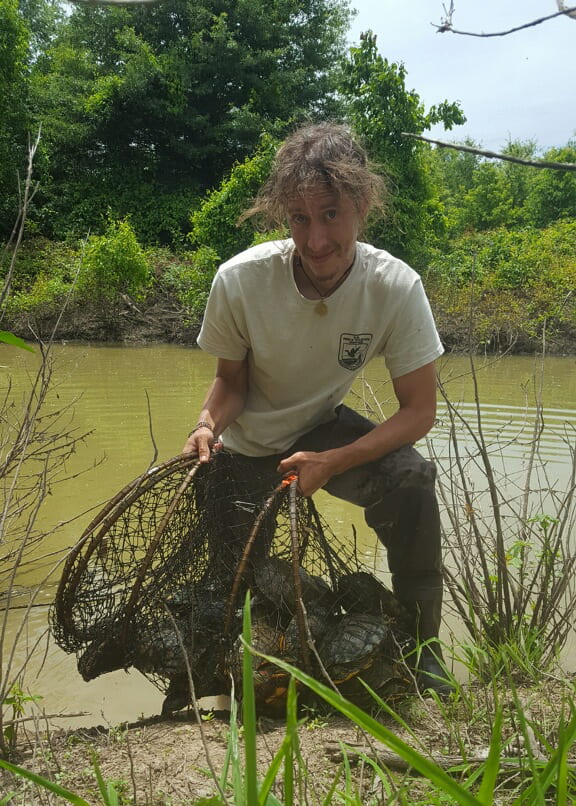Tallying Arkansas’ Turtles

Researchers use a calipers to measure the size of a common snapping turtle (Chelydra serpenta). Photo provided.
Field Notes is our annual look at the work University of Arkansas faculty and student researchers are doing in the state and around the world during the summer. In this post, Brett DeGregorio of the Fish and Wildlife Cooperative Research Unit describes how his team is quantifying turtle populations in the Arkansas delta to better determine the effects of harvesting.
Freshwater turtle populations are declining worldwide and harvest for food markets and the pet trade are frequently cited as drivers of these declines. The export of wild turtles from the United States has been increasing rapidly over the last two decades, likely to meet the demand for Asian markets that have depleted local turtle populations. In Arkansas alone, an estimated 1.3 million wild aquatic turtles were harvested, primarily from the Mississippi Delta region, from 2004 to 2017. Scientifically sound, evidence-based regulations will be crucial for protecting the viability of turtle populations in the United States in the face of intensifying harvest pressure.


Several aspects of turtle ecology and life history make them especially vulnerable to even small amount of harvest. Most turtles do not reach sexual maturity until an advanced age and survival of hatchlings is often very low. Turtle populations are particularly sensitive to adult mortality. Even modest increases in adult mortality (10 percent) can have dramatic long-term effects on population persistence.
In response to concerns regarding overharvesting of turtles, several states have enacted regulations, including size limits.
Andrhea Massey, left, and Elliott Lassiter capture turtles in hoop nets as part of the effort to determine how many remain in the Arkansas Delta. Photo provided.
Most states that enact regulation adopt size limits such that only larger individuals can be harvested, although some states have done the opposite and only allow the harvest of individuals below a certain size. Concerningly, other states have yet to enact any regulation (Louisiana) or allow unrestricted harvest after attaining a permit (Arkansas). As some states restrict harvest, the pressure on surrounding states that lack regulations may intensify.
Harvest regulations may not be enough to save turtles. Some studies have suggested that size restrictions are enough to reduce harvest of snapping turtles by 30-87 percent, but that the number of turtles harvested is still likely to have long-term impacts on populations. To date, we lack a comprehensive understanding of current turtle population levels or species-specific sensitivity to harvest that are needed to guide management that ensures persistence of turtle populations in the state.
Our research seeks to understand how many turtles of the commonly harvested species, such as snapping turtles, red-eared sliders, and spiny softshell turtles, are in the Delta ecoregion of Arkansas, and what effect harvest has on populations. Our team (J.D. Willson, Brett DeGregorio, Andrhea Massey and Elliot Lassiter) set hoop traps, baited with chicken and fish, in wetlands that have been harvested in the past and in wetlands that are protected from harvest. We notch the shell of each turtle in a unique patterns so that we will always know the identity of any previously captured turtles. By using formulas based on the number of turtles we catch each week that are previously marked vs. never before captured by us, we can estimate the number of turtles that occur in different wetlands. We then compare these population estimates between harvested and protected wetlands to understand what, if any effect commercial turtle harvest has on population levels.

A spiny softshell turtle (Apolone pinifera). Photo provided.
By understanding how many turtles may be present in the region and what effect harvest has on populations – we can make suggestions to the Arkansas Game and Fish about how they can regulate harvest to ensure that we never over exploit these charismatic reptiles.



